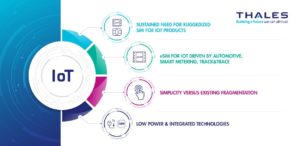Six questions to Marylene Arnoux-Roetynck, eSIM Marketing Manager and Didier Benkoël, Marketing Communications Manager at Thales, on the role of SIM and eSIM in IoT.
What is the difference between M2M (Machine-to-Machine) and IoT (Internet of Things)?
There are no hard and fast rules as to where M2M ends and IoT begins. However, we now generally treat M2M as a segment within the larger IoT market.
As the name suggests, M2M typically refers to use cases involving larger plant and equipment, in areas such as smart manufacturing and the automotive sector.
These are now being joined by a new generation of IoT deployments. In contrast to M2M, IoT is characterised by new types of connected devices, such as sensors and smart meters. And IoT deployments are typically on a much greater scale. They also emphasise the need for low power and extended battery life, space-efficient design, and the ability to operate over a longer lifecycle without human intervention.
What is the role of SIM and eSIM in IoT?
SIM and eSIM are at the heart of any IoT use case that relies on cellular connectivity.
According to a recent Ericsson Mobility Report , in 2021 the IoT comprised a total of 14.6 billion individual connections. Of these, 1.9 billion were cellular connections, representing a 13% share. By 2027, the IoT is predicted to grow to 30.2 billion connections, with cellular connections responsible for 5.5 billion. That’s an 18% share.
Moreover there’s no doubt that the additional benefits of the eSIM will prove increasingly attractive. However, the ‘traditional’ SIM is well-established and extremely popular. In many situations, it will continue to fulfil all the requirements of OEMs, IoT service providers, mobile network operators and end users. By 2026, Thales Market Intelligence predicts a near 50-50 split between SIM and eSIM in the IoT market.
Can IoT devices use the same type of SIM and eSIM as a smartphone?
In a word, no – IoT requires more robust, or ‘ruggedized’, SIM and eSIM than those employed in consumer devices. Depending on the specific use case, SIM and eSIM in IoT may need to withstand greater extremes of temperature, humidity and vibration. Also, SIM and eSIM will usually need to be adapted to longer product lifecycles and low power designs that extend battery life.
For these reasons, SIM and eSIM are also produced in industrial and automotive grades. What’s more, smaller form factors, including Thales’ ultra-compact MFFXS, are available to suit particularly space-constrained designs. Where vibration is an issue, solder options enable the SIM to be surface mounted on the PCB.
However, the terms industrial and automotive are only a guide. Specification must always be driven by the characteristics of the use case itself. It is perfectly possible that an automotive grade SIM or eSIM will be the best option for a non-automotive product.
What are the benefits of eSIM for IoT?
In the IoT ecosystem, the eSIM opens the door to added value services and enhanced flexibility. Crucially, network subscriptions can be provisioned and updated remotely over the entire device lifecycle – that’s a major benefit for massive, remote IoT deployments.
With Thales Instant Connect (TIC), eSIM connectivity can be activated automatically the first time a device is powered up in the field. There is also no longer a need to preload a subscription profile onto the SIM during manufacture. When powered up in the field, the eSIM connects automatically to the preferred local network operator. That means a single SKU can be used for multiple different markets, simplifying manufacturing and logistics. There is also much greater freedom to select different network operators in different countries and regions.
In the years ahead, we’re likely to see further advances in the services available to the eSIM. That makes adopting the eSIM a thoroughly future-proof option.
What other technology developments should we be looking out for when it comes to SIM and IoT?
The iSIM represents the next big thing. With this approach, the SIM is no longer a discrete component. Instead, the iSIM is integrated into another system chip within the product design. This delivers further space and power savings and, by cutting the total number of components, reduces assembly costs. By 2027, analysts predict that almost 20% of the eSIM market will be taken by the iSIM.
Thales is already well advanced in the development of iSIM solutions…..so watch this space!




